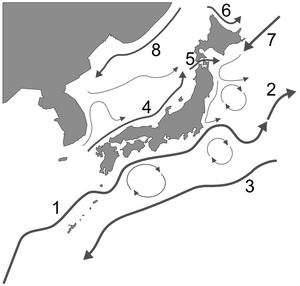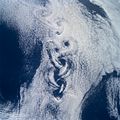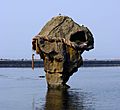Sea of Japan facts for kids
Quick facts for kids Sea of Japan |
|

Sea of Japan map
|
The Sea of Japan/East Sea is a sea in the western Pacific Ocean. It is bordered by Korea to the west, Russia to the north and Japan to the east and south.
South Korea calls it the East Sea, while North Korea calls it the East Sea of Korea.
Contents
Geography
The Sea of Japan is a sea in the north-western edge of the Pacific Ocean. It is divided from this ocean by the Japanese Archipelago, including Sakhalin, Hokkaidō and Honshū. It is surrounded by these islands and the Eurasian Continent. It covers 978,000 square km. The average depth is 1,667 meters. The depth of the deepest point is 3,742 meters. Five (or Six) narrow channels of water link the Sea of Japan and other seas: the Strait of Tartary and La Pérouse Strait with the Sea of Okhotsk; the Tsugaru Strait with the Pacific Ocean; the Kanmon Straits with the Seto Inland Sea; the Busan and Tsushima Strait with the East China Sea.
The Sea of Japan has a shallow area in the part of its center, which is called as the Yamato Bank and not deeper than 1,000 meters. It has three major sea basins, vast plain in the bottom of sea: the Yamato Basin in the southeast, the Japan Basin in the north and the Tsushima Basin in the southwest. These three surround the Yamato Bank counterclockwise. The geographical feature in the deep sea which is described here, serves an important function for the lower layer water and biodiversity in the deep sea.
The oceanic structure of the Sea of Japan can be divided by depth into two: the surface water of higher layer than the depth of 300 meters, and the deep sea water of lower than this. The surface sea currents circulate in the counterclockwise direction. One of them is the Tsushima Current, which is a warm current from the Korean Straits to the north-east direction along the shore of the Japanese Archipelago and mainly considered to be the branch of the Kuroshio Current. The other is the Liman Current, which is a cold current from the Strait of Tartary to the south-west direction along the shore of the Eurasian continent.
In contrast to the surface water, the deep sea water is not displaced much by the water of the other sea because the above-mentioned five channels are narrow and shallow. The deep sea water of the Sea of Japan tends to stay longer in the bottom of the sea than other deep sea water, and is called as "the inherent water of the Sea of Japan", which accounts for the eighty percent of the total amount of its water.
Name
The International Hydrographic Organization(IHO) decided to call this area the "Sea of Japan" in 1929.
Since 1992, South Korea has asked the world to use the names "East Sea" or "Sea of Korea" instead of "Sea of Japan". South Korea argues that this sea has been called "East Sea" since early times. It is also a Korean belief that the name "East Sea" was eliminated from maps of the world in the early 20th century while South Korea was under the rule of Japan.
However, Japan says that the name "Sea of Japan" has been used more widely than "East Sea" in Europe and America since before the 18th century. Japan also argues that if there were no Japan, there would be no sea.
Currently, most international maps and documents use the name Sea of Japan only. However, in some cases, the name East Sea is included along with the name Sea of Japan.
Images for kids
-
The Tumen River flows into the Sea of Japan. The last 17 km of the river form the border between North Korea and Russia. This picture is of the Korea Russia Friendship Bridge that crosses the Tumen River.
-
The mouth of Partizanskaya River near Nakhodka. View from Sopka Sestra.
-
Sea lions on Moneron Island
See also
 In Spanish: Mar del Japón para niños
In Spanish: Mar del Japón para niños














